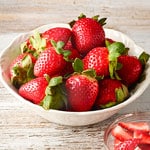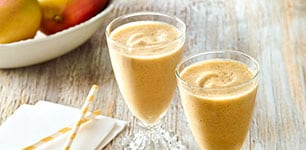 February is American Heart Month. By making changes in your lifestyle, including your eating habits, you may reduce your risk for heart disease. According to the 2010 Dietary Guidelines for Americans, moderate evidence indicates that intake of at least 2 1/2 cups of vegetables and fruit per day is associated with a reduced risk of cardiovascular disease, including heart attack and stroke.
February is American Heart Month. By making changes in your lifestyle, including your eating habits, you may reduce your risk for heart disease. According to the 2010 Dietary Guidelines for Americans, moderate evidence indicates that intake of at least 2 1/2 cups of vegetables and fruit per day is associated with a reduced risk of cardiovascular disease, including heart attack and stroke.
Most Americans are lacking when it comes to their fruit and vegetable intake. A study by the CDC (Centers for Disease Control) reported that 87 percent of Americans don't meet recommendations for fruit consumption, and 91 percent don't meet recommendations for vegetable consumption.
How much do you need?
The amount of fruits and vegetables you need to eat depends on your age, sex, and level of physical activity. Recommended total daily amounts and recommended weekly amounts from each vegetable subgroup are shown in the two charts below.
Know your servings.
What is a cup?
In general, 1 cup of fruit or 100% fruit juice, or a 1/2 cup of dried fruit can be considered as 1 cup from the fruit group. The chart below shows specific amounts that count as 1 cup of fruit toward your daily recommended intake.
In general, 1 cup of raw or cooked vegetables or vegetable juice, or 2 cups of raw leafy greens can be considered as 1 cup from the vegetable group. The chart below lists specific amounts that count as 1 cup of vegetables.
Tips to increase fruit and vegetable intake.
Follow these tips to increase your fruit and vegetable intake:
Sources:
- Moore, PhD, Latetia V., and Frances E. Thompson, PhD. "Adults Meeting Fruit and Vegetable Intake Recommendations — United States, 2013." Centers for Disease Control and Prevention. July 10, 2015.
- All About the Fruit Group." ChooseMyPlate.gov. February 11, 2015.
- All About the Vegetable Group." ChooseMyPlate.gov. February 12, 2015.
- Quick Guide to Getting More Fruits & Vegetables." Fruits & Veggies—More Matters. Accessed December 1, 2015.
- 30 Ways in 30 Days to Stretch Your Fruit & Vegetable Budget." Fruits & Veggies—More Matters. Accessed December 1, 2015.
Recipes
Taking Steps Toward Better Health
The journey toward healthy living isn't always easy, but there are many great resources that can provide tips and information to help encourage you along the way.
- OVERALL HEALTH - Only 1 in 10 Americans Eats Enough Fruits and Veggies: CDC
- OBESITY - How to Use Fruits and Vegetables to Help Manage Your Weight
- HEART HEALTH - Can Antioxidants in Fruits and Vegetables Protect You and Your Heart?
- DIABETES - Eating Whole Fruits Linked to Lower Risk of Type 2 Diabetes
- AVOIDANCES - Food Allergy: Symptoms
Health Articles

Lighten Up for the Holidays
Make a few better choices to lighten up during the holidays.

 You are about to leave publix.com and enter the Instacart site that they operate and control. Publix’s delivery and curbside pickup item prices are higher than item prices in physical store locations. Prices are based on data collected in store and are subject to delays and errors. Fees, tips & taxes may apply. Subject to terms & availability. Publix Liquors orders cannot be combined with grocery delivery. Drink Responsibly. Be 21. For prescription delivery, log in to your pharmacy account by using the Publix Pharmacy app or visiting
You are about to leave publix.com and enter the Instacart site that they operate and control. Publix’s delivery and curbside pickup item prices are higher than item prices in physical store locations. Prices are based on data collected in store and are subject to delays and errors. Fees, tips & taxes may apply. Subject to terms & availability. Publix Liquors orders cannot be combined with grocery delivery. Drink Responsibly. Be 21. For prescription delivery, log in to your pharmacy account by using the Publix Pharmacy app or visiting 